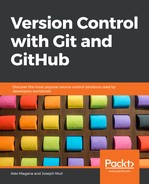Book Description
Learn to create and enforce checks and controls for tracking, merging, and approval of changes in your source code
Key Features
- Explore version control, its importance, and usage
- Learn to use Git individually and as part of a team
- Understand debugging, maintenance, and deployment with Git and GitHub
Book Description
Introduction to Git and GitHub begins with setting up and configuring Git on your computer along with creating a repository and using it for exercises throughout the book. With the help of multiple activities, you'll learn concepts that show various stages of a file - from when it is untracked to when it is set for tracking under version control. As you make your way through the chapters, you'll learn to navigate through the history of a repository, fetch and deliver code to GitHub, and undo code changes.
The first half of the book ends with you learning to work with branches, storing and retrieving changes temporarily, and merging the desired changes into a repository.
In the second half, you'll learn about forking as part of a collaborative workflow. You'll also address modularity and duplication through submodules, tracing and rectifying faulty changes, and maintaining repositories.
By the end of this book, you will have learned how to effectively deploy applications using GitHub.
What you will learn
- Understand and implement best practices in version control
- Explain the GitHub User Interface
- Understand what is Feature Branch Workflow and implement its features
- Use forking features, such as submodules and rebasing
- Master commands for debugging and maintaining a repository
- Implement continuous integration with CircleCi or TravisCi
- Gain insight into release management and how GitHub enables software releases
Who this book is for
If you want to migrate from other version control tools or want to learn more about Git, Introduction to Git and GitHub is for you. Prior experience in coding or familiarity with using the Bash command line interface will help you easily grasp concepts.
